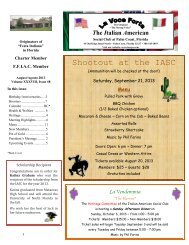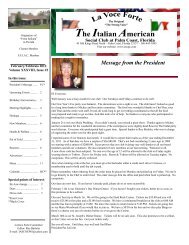Independence Day Dinner Dance - IASC
Independence Day Dinner Dance - IASC
Independence Day Dinner Dance - IASC
Create successful ePaper yourself
Turn your PDF publications into a flip-book with our unique Google optimized e-Paper software.
P.5<br />
NAPLES<br />
The Italian name is Napoli. The people living there are called in English Neapolitans. Yes, it is an ice cream too. In Italian<br />
they are Napolitani, the singular being Napolitano. Many individuals have that as a last name and usually they originate from Naples.<br />
Naples is the regional capital of Campania. The city is known for its rich history, art and cultural aspects to the extent that, it has been<br />
classified as a world heritage site by UNESCO.<br />
The city is considered to be 2,800 years old. The ancient Greeks founded the city and it was a part of Magna Graecia until the<br />
arrival of the Romans, who made it a capital of that part of the empire. The Greek name for the city was Neapolis, or in English New<br />
City. The city has seen a multitude of cultures and conquerors come and go. It was, as stated, a part of Magna Graecia, then the Roman<br />
Empire, part of France, part of Spain, part of the Empire of the Saracens, an independent Kingdom and, for a period of time an<br />
independent Maritime nation and lastly it became a part of Italy during the unification struggles in the 1860’s.<br />
Naples is also known for its music, cuisine and the famous pizza. The people speak a Neapolitan dialect that is consistent<br />
with the dialects of the surrounding area. The bordering provinces are Lazio, Molise, Basilicata, and Puglia. When thinking of Naples<br />
the most frequent aspects that come to mind is Mt. Vesuvius (Monte Vesuvio) and Pompeii. Mt. Vesuvius has erupted many times,<br />
(thirty-three since 1800 BC.) the worst occurring that year, the Avellino Eruption. Italy has three volcanoes, the aforementioned, the<br />
Stromboli and the Etna, both being on islands and not posing as much of a threat. Mt Vesuvius is the most dangerous volcano in the<br />
world not only for its history of eruptions, but also for the human victimization. Three million people live in the danger zone. Its name<br />
comes from Greek in reference the son of Zeus, Hercules in the ancient Greek language somehow worked into Vesuvius. Mt. Vesuvius’<br />
most famous or noted eruption was the one of AD 79 when its ash covered Pompeii and a number of other towns around its<br />
base. This occurrence provided archeologists and historians a wealth of information on how people lived two thousand years ago. Areas<br />
of Pompeii and Herculaneum are still being uncovered. There are a number of private villas that existed in the countryside that as<br />
yet remain to be uncovered.<br />
Two ancient writers of that time, Pliny the Elder and Younger were on the opposite side of the bay during the eruption. However,<br />
Pliny the Elder sailed across the bay to rescue friends, but the winds and smoke blocked his return. He died on the beach trying<br />
to make it to his boat. Others with him survived. It is believed he died from a heart attack for the next day his body was found and it<br />
was in good condition. The most reliable account of the eruption is from Pliny the Younger (the nephew) who was seventeen years<br />
old at the time and subsequently wrote about it.<br />
Nearby, of which many people are unaware is the ancient city of Paestum, settled by the Greeks in the 7 th century B.C. The<br />
local Oscan people and the Greeks lived harmoniously. Its original name was Poseidonia after the Greek god Poseidon. The name is<br />
equal to the Roman god Neptune. When Hannibal was raising havoc in the peninsula the people kept their allegiance to Rome. After<br />
the defeat of Hannibal it received special recognition and was able to mint its own coinage. The town declined in the middle ages and<br />
became overgrown with weeds and vines until 1840 when a new interest in things ancient became popular. The city was uncovered to<br />
reveal a number of temples still standing that were built in the 7 th Century B.C. Paestum is about fifty miles south of Naples. It is well<br />
worth a visit. I recently visited again in June this past year.<br />
Laurence Amuso, Member Heritage Committee<br />
In accordance with the by-laws, the General Election was held on Wednesday, May 19, 2010 to select the officers and directors who will serve on the<br />
2010-2011 Executive Board. Based on the outcome of the election, the 2010-2011 Executive Board will be comprised of the following members:<br />
President:<br />
Vice President:<br />
Secretary:<br />
Treasurer:<br />
Director (Incumbent*):<br />
Director (Incumbent*):<br />
Director (Incumbent*):<br />
Director<br />
Director<br />
Director<br />
Joe Minotti<br />
Pat LaCorte<br />
Marie Luke<br />
Tomme Mayne<br />
Pete DiGuilio<br />
Jerry Esposito<br />
Donna Macaluso<br />
Lois Big Mountain<br />
Rosemarie Corbo<br />
Honey Maresco<br />
*Incumbent Directors will be serving the last year of their two-year commitment.<br />
The Committee thanks the members for their participation and cooperation in the election process.<br />
My thanks to Committee members Roseann Vastano, Joe Abitante, and Larry Amuso and also to Rosemarie and Marty Litwak and AnneMarie<br />
Walker who generously agreed to assist in the balloting and tallying procedures on election night.<br />
Tom Fallon, Election Chairperson









